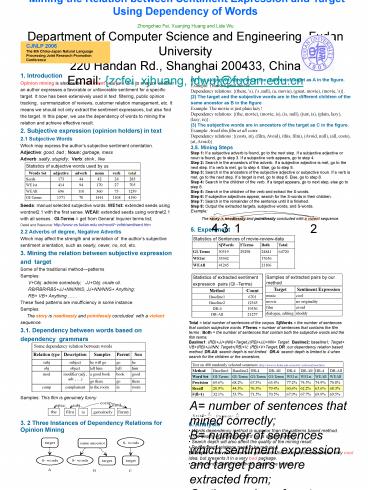1. Introduction - PowerPoint PPT Presentation
1 / 1
Title:
1. Introduction
Description:
(1) The subjective words are in the children of target as A in the figure. ... 220 Handan Rd., Shanghai 200433, China. Email: {zcfei, xjhuang, ldwu}_at_fudan.edu.cn ... – PowerPoint PPT presentation
Number of Views:74
Avg rating:3.0/5.0
Title: 1. Introduction
1
Mining the Relation between Sentiment
Expression and Target Using Dependency of Words
Zhongchao Fei, Xuanjing Huang and Lide
WuDepartment of Computer Science and
Engineering, Fudan University220 Handan Rd.,
Shanghai 200433, ChinaEmail zcfei, xjhuang,
ldwu_at_fudan.edu.cn
CJNLP 2006The 6th China-Japan Natural Language
Processing Joint Research Promotion Conference
- 1. Introduction
- Opinion mining is also called sentiment analysis.
It is to analyze whether - an author expresses a favorable or unfavorable
sentiment for a specific - target. It now has been extensively used in text
filtering, public opinion - tracking, summarization of reviews, customer
relation management, etc. It - means we should not only extract the sentiment
expressions, but also find - the target. In this paper, we use the dependency
of words to mining the - relation and achieve effective result.
- 2. Subjective expression (opinion holders) in
text - 2.1 Subjective Words
- Which may express the authors subjective
sentiment orientation. - Adjective good, bad Noun garbage, mess
- Adverb sadly, stupidly Verb stink , like
- (1) The subjective words are in the children of
target as A in the figure. - Example There's a great movie!
- Dependency relations (there, 's), ('s ,null),
(a, movie), (great, movie), (movie, 's). - (2) The target and the subjective words are in
the different children of the same ancestor as B
in the figure - Example The movie is just plain lazy!
- Dependency relations (the, movie), (movie, is),
(is, null), (just, is), (plain, lazy), (lazy,
is). - (3) The subjective words are in ancestors of the
target as C in the figure. - Example Avoid this film at all costs.
- Dependency relations (costs, at), (film,
Avoid), (this, film), (Avoid, null), (all,
costs), (at, Avoid) - 3.5. Mining Steps
- Step 1 If a subjective adverb is found, go to
the next step. If a subjective adjective or noun
is found, go to step 3. If a subjective verb
appears, go to step 4. - Step 2 Search in the ancestors of the adverb. If
a subjective adjective is met, go to the next
step. If a verb is met, go to step 4. Else, go to
step 8. - Step 3 Search in the ancestors of the subjective
adjective or subjective noun. If a verb is met,
go to the next step. If a target is met, go to
step 6. Else, go to step 8. - Step 4 Search in the children of the verb. If a
target appears, go to next step, else go to step
8. - Step 5 Search in the children of the verb and
extract the S-words. - Step 6 If subjective adjectives appear, search
for the S-words in their children. - Step 7 Search in the remainder of the sentence
until it is finished. - Step 8 Output the extracted targets, subjective
words, and S-words. - Example
4
3
1
2
Total total number of sentences of the corpus.
SjWords the number of sentences that contain
subjective words. FTerms number of sentences
that contains the film terms Both the number
of sentences that contain both the subjective
words and the film terms. Basline1
(RB)JJ(NN)Target,((RB)JJ)NN Target.
Basline2 baseline1 Target VB(RB)JJ/NN
Target(RB)V (RB)VTarget DR our dependency
relation based method. DR-All search depth is
not limited. DR-4 search depth is limited to 4
when search for the children or the ancestors.
A number of sentences that mined correctly B
number of sentences which sentiment expression
and target pairs were extracted from C the
number of sentences that contain coherent
sentiment expression and target pairs.
- 6. Analysis
- Words dependency method is superior than the
patterns based method. - The quality of subjective word set is very
important. - Search depth will also affect the quality of the
mining result. - Redundancy relations need to be reduce,
- Example A movie for the teen generation that
touches on a Example very cool idea, but
presents it in a very bad package. - Dependency relation instances need to be refined.

